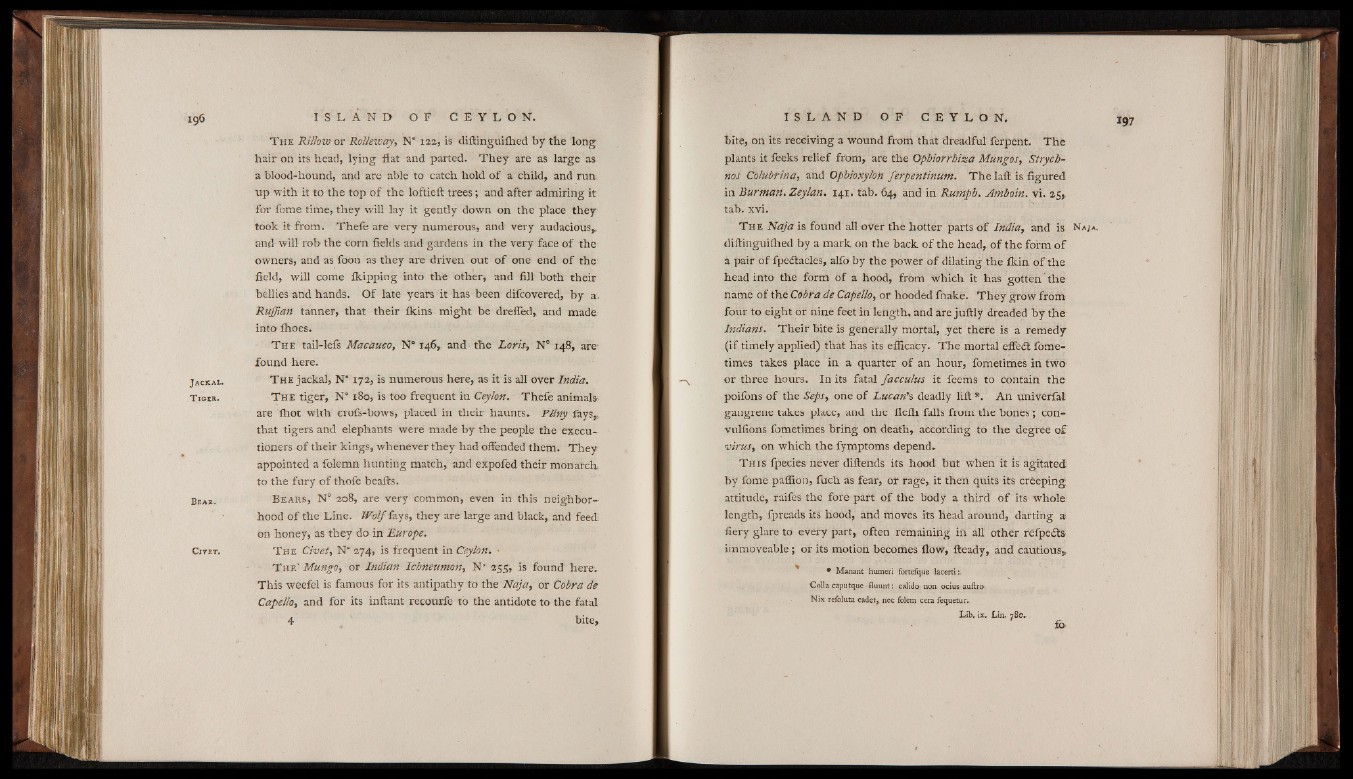
J a c k a l .
T.iger.
Beak.
Civet.
The Rillow or Rolleway, N" 122, is diftinguiihed by the long
hair on its head, lying flat and parted. They are as large as
a blood-hound, and are able to catch hold of a child, and run
up with it to the top o f the loftieft trees; and after admiring it
for fome time, they will lay it gently down on the place they
took it from. Theie are very numerous, and very audacious,,
and will rob the corn fields and gardens in the very face of the
owners, and as foon as they are driven out o f one end of the
field, will come ikipping into the other, and fill both their
bellies and hands. Of late years it has been difcovered, by a.
Ruffian tanner, that their ikins might be dreffed, and made
into Ihoes.
T h e tail-lefs Macaueo, N* 146, and the Loris, N° 148, are-
found here.
The jackal, N' 172, is numerous here, as it is all over India.
T h e tiger, N" 180, is too frequent in Ceylon. Thefe animals;
are fhot with crofs-bows, placed in their haunts. Pliny fays,
that tigers and elephants were made by the people the executioners
of their kings, whenever they had offended them. They
appointed a folemn hunting match, and expofed their monarch
to the fury o f thofe beafts.
Bears, N° 208, are very common, even in this neighborhood
o f the Line. Wolf fays, they are large and black, and feed
on honey, as they do in Europe.
T h e Civet, N° 274, is frequent in Ceylon. •
T h e ' Mungo, or Indian Ichneumon, N” 255, is found here.
This weefel is famous for its antipathy to the Naja, or Cobra de
Capello, and for its inftant recourfe to the antidote to the fatal
4 bite,
bite, on its receiving a wound from that dreadful ferpent. The
plants it feeks relief from, are the Opbiorrhiza Mungos, Strych-
nos Colubrina, and Ophioxylon ferpentinum. The lafl is figured
in Burman. Zeylan. 141. tab. 64, and in Rumph. Amboin. vi. 25,
tab. xvi.
T h e Naja is found all over the hotter parts o f India, and is Naja.
diftinguiihed by a mark on the back of the head, o f the form of
a pair of fpecftacles, alfo by the power o f dilating the ikin o f the
head into the form of a hood, from which it has gotten the
name of the Cobra de Capello, or hooded fnake. They grow from
four to eight or nine feet in length, and are juftly dreaded by the
Indians. Their bite is generally mortal, yet there is a remedy
£if timely applied) that has its efficacy. The mortal effeft fome-
times takes place in a quarter of an hour, fometimes in two-
or three hours. In its fatal facculus it feems to contain the
poiibns of the Seps, one of Lucan’s deadly lift *. An univerfal
gangrene takes place, and the flefh falls from the bones; con-
vulfions fometimes bring on death, according to the degree of
virus, on which the fymptoms depend.
T h i s fpecies never diftends its hood but when It is agitated
by fome paffion, iuch. as fear, or rage, it then quits its creeping
attitude, raifes the fore part o f the body a third o f its whole
length, fpreads its hood, and moves its head around, darting a
fiery glare to every part, often remaining in all other refpeits
immoveable; or its motion becomes flow, fteady, and cautious,
* Manant humeri fortefque lacerti:.
Colla caputque fluunt: calido non ocius auftro-.
Nix refoluta cadet, nec folem cera fequetur.
Lib. ix. Lin. 780.-
£□